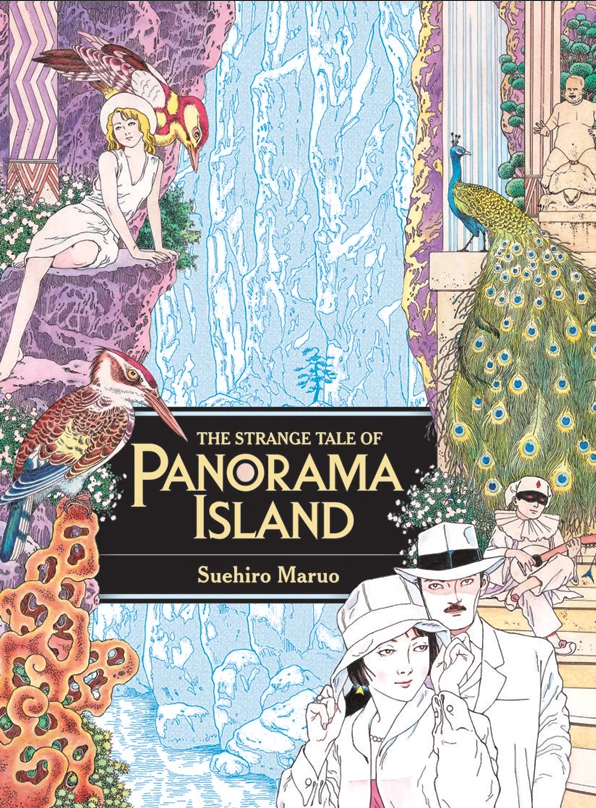Your Cart is Empty
Artists

A Voyage of Death, Rebirth & Death in "The Strange Tale of Panorama Island"
October 09, 2019 3 min read 0 Comments
A ship cuts its way across tumultuous water to find an impossible island. A man enthusiastically takes the place of the dead. A woman wonders if her husband is still her husband. The world is upended and reality shifts at the whims of one man in Suehiro Maruo’s "The Strange Tale of Panorama Island", published by Last Gasp. Based on the novella by Edogawa Rampo, and released in the US in 2013 (originally published in Japan from 2007 to 2008), Panorama is one of the few titles released in English from the cult manga author and illustrator, Suehiro Maruo.
Panorama Island’s antihero is Hitomi Hirosuke, a destitute writer who dreams of living on an island utopia of his own creation. Hirosuke receives news that his insanely wealthy college friend, Komoda, had passed away. Since Komoda and Hirosuke look almost identical to each other, Hiroskue schemes to fake his own death, then pose as Komoda risen from the grave, utilizing his elaborate fortune to construct a personal paradise. Looming over Hirosuke’s plans is the late Komoda’s wife, the one person that could potentially unravel Hirosuke’s ruse.
Based on the novella by Edogawa Rampo, Maruo’s interpretation of The Strange Tale is not only an adaptation of Rampo’s story, but it becomes an encapsulation of pre-WWII Japan. The story is set at the very end of the Taisho era (1912 - 1926), a period in time that saw the rise of Japan’s modern consumer culture, the rise of cinema, and great upheaval in urban life just before the onset of the Showa era (1926 - 1989) and the bloody Pacific War that followed with it. Maruo takes us on a grand tour of Japan during the 1920s, marveling at the style of this period before Japanese fascism and American firebombings turned it all to ash.
The original author of Panorama Island, Edogawa Rampo, holds a special place in Japan’s pop cultural and literary zeitgeist as Japan’s patron saint of murder mysteries (his name is based on a Japanese pronunciation of Edgar Allan Poe) and erotic horror. There have been no shortage of films, comics, and animated works adapting his stories, but Suehiro Maruo brings a unique style to his recreation of Rampo’s visions. Suehiro Maruo is one of Japan’s foremost artists of erotic grotesque, often abbreviated to ero-guro. This genre grew out of the artistic/literary movement in Japan known as “erotic grotesque nonsense” a term that was originally meant to condemn works that didn’t uphold good morals, but morphed into a badge of honor for authors and artists, including Rampo himself.
Maruo began drawing manga in the early 1980s, but has a style that has always looked to Japan’s past. Maruo has a cult following throughout Japan, and while never a household name, his output was prolific enough to appear on posters for films, the theater, album covers, book illustrations and more. His stories, such as "Mr. Arashi’s Amazing Freak show", and "DDT", deal with themes of inescapable social isolation combined with shocking sexual violence dressed up in the stylization of 1920s silent films. Maruo’s work borrows heavily from German impressionist cinema, classical Japanese art, experimental theater and American horror films. All these influences contribute to Maruo’s own eclectic style. Rampo’s influence in particular is felt throughout almost all of Maruo’s work, through his fascination with the elegant juxtaposed with the putrid. This has taken shape in some indirect ways, such as the character Masamitsu from Maruo’s "Mr. Arashi’s Amazing Freak Show", similar to murderous and maligned title character from Rampo’s "The Dwarf". Maruo also adapted Rampo’s The Caterpillar, the story of a mute and deformed World War I vet and his strained relationship with his wife.
While Panorama Island still contains grave robbing, wanton excess, and a dash of necrophilia, it’s a relatively restrained story compared to Maruo’s earlier work. Instead of utilizing shock, Maruo lets his sense of detail in recreating early 20th century Japan do the legwork in Panorama Island. Long time fans might consider this Maruo pulling his punches a little bit, but this comic puts his skills as an artist on full display, and this story might be more palatable to new readers that might not be familiar with his more extreme works. "The Strange Tale of Panorama Island" is a horror-mystery that transports its readers to a place where wishes some people would rather not admit they have are indulged upon.
Subscribe
Sign up to get the latest on sales, new releases and more …
